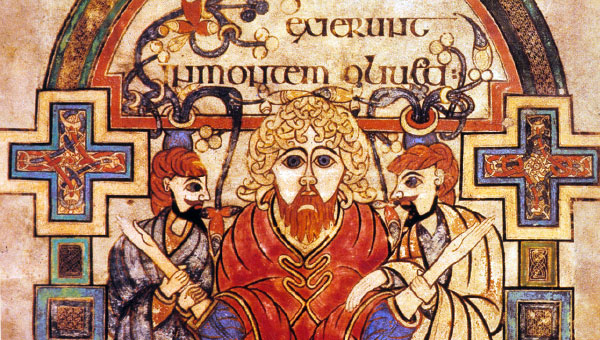Illuminating the Irish Church


Thanks to the kindness of Amanda Dillon, the Jesuit Library at Milltown currently has a splendid facsimile edition of the Book of Kells on loan and on public display. In time-honoured fashion, a new page is turned each dayby the Librarian. Amanda won the facsimile copy as first prize in the Boyne Valley Honey Art Competition some years ago. Her prize-winning icon of Eadwin the monk at work in his scriptorium is also on display in Milltown. A second series of four Public Lectures on Early Irish Religious Texts was hosted by the Milltown Institute throughout the month of November. The first series, held two years ago, proved to be very popular.
David Kelly O.S.A. opened the series with a lecture entitled Sacra Pagina: Visual Expressions of Spirituality in Early Christian Irish Texts. His lecture considered the importance of the sacra pagina in the early Irish Church and the kind of texts and versions of the bible in use in Ireland. He gave specific attention to two 7th century manuscripts, the Cathach (Psalter) and the Book of Durrow (Gospel Book). Reference was made to the texts of these manuscripts and their accompanying illumination. These texts were chosen, not only because of the artistic elements of their composition, but also because of their visual witness to the lively and imaginative expression of a Christian Spirituality, alert to the power and impact of the inspired word of God.
Finbarr Clancy S.J. delivered the second lecture on Portraits of Mary in the Book of Kells and Poetic Sources. He began by looking at the Latin hymn Cantemus in omni die, composed by Cú Chuimne of Iona. The hymn’s elaborate structure, theology, imagery and likely Patristic inspiration for some of its Mariology, were explored. The lecture examined is some detail the portrait of the Virgin and Child on folio 7v in the Book of Kells, noting some peculiarities of this earliest known portrait of Mary in a Western manuscript. Possible sources of inspiration for this portrait were outlined, including Coptic influences. The third part of the lecture explored the distinctive Mariological characteristics of the two poems of Blathmac written in old Irish c.750AD.
In the third lecture Amanda Dillon introduced us to the Saint John’s Bible, the first handwritten and illuminated manuscript to be commissioned by a Benedictine Abbey (St John’s Abbey, Collegeville, Minnesota) in over 500 years. Reviving the ancient and organic traditions of the medieval scriptorium, it also made use of computer programmes to layout exquisite pages of biblical text, written using goose-feather quills with century-old Chinese inks on calfskin vellum. Aided by the prayerful exegesis of scholars, historians and monks of the Abbey – expansive and daring illuminations and flashes of gold burst off the page, bringing the Word of God to life in our context. It is rightly heralded as “America’s Book of Kells”.
In the final lecture in the series Thomas Whelan C.S.Sp. introduced the audience to the Stowe Missal. This may be a copy, made around 830 AD in North Tipperary, from a book that originally came from Tallaght. The Missal contains an Ordo Missae, an Ordo baptismi, and a Visitation of the Sick, followed by a tract on the Mass in old Irish. The second half of the lecture dealt with two prayers from the baptism order, indicating that, contrary to the general opinion that it is basically a Romanised text, the first of the baptismal prayers shows that it does not have direct dependence on any of the Roman-influenced versions of this prayer, and that, indeed, its sources include Spain and Gaul.
The lectures were well attended and elicited lively questions from an interested audience.


